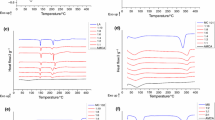Abstract
Purpose
Fulvic acid is a polymer that acts as a carrier to a number of drugs by its great complexing ability, thereby augmenting their bioavailability. Conventional procedure of extraction is available, but it involves long extraction times and a number of rudimentary steps. The purpose of this study was to overcome this issue.
Methods
The extraction of fulvic acid was carried out from a solid dosage form using microwave-assisted extraction (MAE) technique, and the effects of variables were studied on its percentage yield by using a “4-Factorial 2-Level statistical model.” Fulvic acid so obtained was characterized for physicochemical properties, spectroscopic analyses, and elemental composition to access its integrity.
Results
The process was statistically optimized with 4-Factorial 2-Level model with 16 runs. The maximum yield of 45.5 mg/g was obtained on levels, viz., temperature (75 °C), time (5 min), number of repeated extractions (1), and solid/liquid ratio (1:4), whereas the predicted yield under similar conditions was found to be 44.5 mg/g and this verified our experimental results statistically.
Conclusions
MAE can be considered as a new and fast method of extraction for many natural substances including fulvic acid.












Similar content being viewed by others
References
Ghosal S. Delivery system for pharmaceutical, nutritional and cosmetic ingredients. US Patent 6,558,712 (2003).
Buffle J, Greter FL, Haerdi W. Measurement of complexation properties of humic and fulvic acids in natural waters with lead and copper ion-selective electrodes. Anal Chem. 1977;49:216–22.
Wang L, Weller CL. Recent advances in extraction of nutraceuticals from plants. Trends Food Sci Tech. 2006;17:300–12.
Javed S, Kohli K, Ali M. Application of response surface methodology to microwave-assisted extraction of lysergol from ipomoea genus and its characterization by RP HPLC-UV. J Pharm Innov. 2011;6:88–96.
Romaris-Hortas V, Moreda-Pineiro A, Bermejo-Barrera P. Application of microwave energy to speed up the alkaline extraction of humic and fulvic acids from marine sediments. Anal Chim Acta. 2007;602:202–10.
Khanna R, Witt M, Anwer MK, Agarwal SP, Koch BP. Spectroscopic characterization of fulvic acids extracted from the rock exudates shilajit. Org Geochem. 2008;39:1719–24.
Baddi GA, Hafidi M, Cegarra J, Alburquerque JA, Gonzalvez J, Gilard V, et al. Characterization of fulvic acids by elemental and spectroscopic (FTIR and 13C-NMR) analyses during composting of olive mill wastes plus straw. Bioresour Technol. 2004;93:285–90.
Stevenson FJ. Humus chemistry: genesis, composition, reaction. New York: John Wiley and Sons; 1982. p. 443.
Carter RJ, Hoxey A, Verheyen TV. Complexation capacity of sediment humic acids as a function of extraction technique. Sci Total Environ. 1992;125:25–31.
Moreda-Pineiro A, Bermejo-Barrera A, Bermejo-Barrera P. New trends involving the use of ultrasound energy for the extraction of humic substances from marine sediments. Anal Chim Acta. 2004;524:97–107.
Maximum yield magazine Canada http://www.bioag.com/images/MY_can_NovDec09_40-44.pdf.
Alvarez-Puebla RA, Valenzuela-Calahorro C, Garrido JJ. Theoretical study on fulvic acid structure, conformation and aggregation: a molecular modelling approach. Sci Total Environ. 2006;358:243–54.
Acknowledgments
S. Javed wishes to thank the Indian Council of Medical Research, New Delhi, India for the financial assistance in the form of Senior Research Fellowship. The authors are thankful to Central Instrumentation Facility, Jamia Hamdard, New Delhi for providing different instrument facilities.
Conflict of Interest
Authors declare no conflict of interests.
Author information
Authors and Affiliations
Corresponding author
Rights and permissions
About this article
Cite this article
Javed, S., Kohli, K. & Ali, M. Microwave-Assisted Extraction of Fulvic Acid from a Solid Dosage Form: a Statistical Approach. J Pharm Innov 8, 175–186 (2013). https://doi.org/10.1007/s12247-013-9157-y
Published:
Issue Date:
DOI: https://doi.org/10.1007/s12247-013-9157-y




